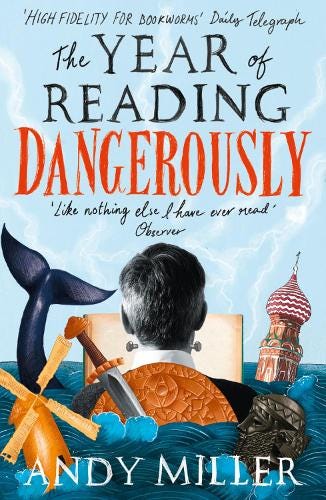A short history of the To Be Read list
A harmless minor pleasure or a chronic exercise in futility?
Everybody has a TBR pile. Not everybody laminates it, but we all have some kind of list of titles we’d like to read, or feel we ought to read, either specifically written down or airily in our head.
Part of the blame for this falls on banker and philanthropist Sir John Lubbock (1834-1913). Hardly a household name today, Lubbock was an important chap of his time. He was the MP responsible for introducing the Bank Holidays Act (1871) and, more pertinently to this newsletter, as the Principal of the Working Men’s College in London, he gave a speech in 1886 in which he listed 100 books.
"I drew up the list,” he said, one which excluded living authors, “not as that of the hundred best books, but, which is very different, of those which on the whole are perhaps best worth reading." It was then published and became a bestseller, with a Booker Prize-like knock-on effect on the books mentioned.
His top 100 (which appears to be more like 100-ish on close inspection) was organised by category, philosophy, travel, history, and so on, but he was wary about a ‘science’ section on the basis that “science is so rapidly progressive”. Also, these were not personal favourites. “As regards the Shi King and the Analects of Confucius, I must humbly confess that I do not greatly admire either; but I recommended these because they are held in the most profound veneration by the Chinese race.”
Following close on Lubbock’s coat-tails was Dean of Canterbury and Marlborough Headmaster Frederic William Farrar who wrote a series of monthly articles for The Sunday Magazine in 1898 along similar lines, though with rather more literature.
But not everybody was a great fan of the concept. Oscar Wilde wrote to the Pall Mall Gazette in 1886 that a more important list would be the Worst Hundred Books so readers would know what to avoid. Indeed, Philip Waller in his excellent book Writers, Readers and Reputations: Literary Life in Britain 1870-1918 writes that these kinds of ‘best books’ lists seem to some people like a “chronic exercise in futility”.
Over the last couple of decades there has been a minor flood of books that chart personal relationships with book lists. Rare book dealer Rick Gekoski says he was the first to coin the term ‘bibliomemoir’, using it in his book Outside of a Dog which listed 25 books which have been particularly special for him throughout his life, from Horton Hatches the Egg by Dr. Seuss via Roald Dahl’s Matilda to Ludwig Wittgenstein’s Philosophical Investigations.
Arguably the Godfather of Bibliomemoirists is Henry Miller whose The Books in My Life took a wideranging look at how and what he read, covering issues such as reading in the toilet and, inevitably, including a list of the 100 books that most influenced him, starting with the slightly vague ‘Ancient Greek Dramatists’ and ending up with Walt Whitman’s Leaves of Grass. It also features a section revealing which friends supplied him with books and another on those books he still intended to read (such as The Pickwick Papers by Charles Dickens). He promised a follow-up volume which he threatened would include everything he could remember reading. This never materialised.
Some bibliomemoirs simply recount a life in books. Anne Fadiman’s Ex Libris looks at how to go about merging libraries when you get married as well as recounting how she built dens out of her father’s books as a child, while in her How to be a Heroine, Samantha Ellis analyses how her heroines have influenced how she has lived her life. Although also focusing on the theme of heroism, Azar Nafisi’s Reading Lolita in Tehran: A Memoir in Books is a rather more serious memoir with sections entitled "Lolita", "Gatsby", "James", and "Austen" in which she examines the often oppressive challenges of life in Iraq in the 1980s and 1990s.
Others are accounts of specific projects. Christopher Beha (The Whole Five Feet: What the Great Books Taught Me About Life, Death and Pretty Much Everything Else) read all 51 volumes of the Harvard Classics, a collection of books collectively measuring five feet put together by Charles William Eliot, a former Harvard president. Eliot believed that together they provided “a means of obtaining such a knowledge of ancient and modern literature as seems essential to the twentieth-century idea of a cultivated man.” (He upped the size from his original claim that three feet would be sufficient).
Andy Miller (The Year of Reading Dangerously) rounded up a similar number of books, what he describes as a List of Betterment, to tackle the classics that he – and, frankly, many others of us – have never read. The result is as much about a Croydon childhood and the Puffin Club as it is about Beowulf or Luke Rhinehart’s The Dice Man. Phyllis Rose (A Year of Reading Proust) made a far more random choice when she decided to simply read everything on the LEQ to LES shelf in the New York Society Library.
While bibliomemoirs tend to focus on a small range of titles – or even, like John Baxter’s account of book buying and dealing A Pound of Paper, teeter on the edge of straight biography - others such as Rebecca Mead’s focus on a single author or work (My Life in Middlemarch). At the other extreme is Susan Hill (Howards End Is on the Landing: A Year of Reading From Home) who spent a year essentially rereading her entire library rather than buying any new books (a year seems to be a key length of time for many bibliomemoirists, apart from Nick Hornby (Ten Years in the Tub: A Decade Soaking in Great Books) who has written a decade of columns for The Believer magazine revealing what he has read and what he has bought month by month). At the end of the 12 months, she draws up a list of 40 titles. While admitting that these are not the best ever written, they are the ones she thinks “I could manage with alone, for the rest of my life".
Which is all rather a longwinded way of getting to the point, which is that I’m doing very much the same thing as all the fine folk above for a book project which hopefully will see the light of day in 2025, more of which next week…







My grandfather once told me I would probably never get around to reading all the books on my TBR list. He was quite right, though it hasn’t stopped me from adding to it - currently numbering 5,510 books. If anything, as long as one never stops reading, one always has something (or many things) to think about. Hopefully one reads widely and becomes a more well-rounded person because of it.
Sadly I am the slowest, most distractible reader in history so my 'books I've read this year' pile tends to be similar to what many read in a month. Which, as you can imagine, means my book to be read list is H U G E